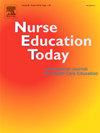护生现实冲击量表的编制与心理测试
IF 4.2
2区 医学
Q1 EDUCATION, SCIENTIFIC DISCIPLINES
引用次数: 0
摘要
目的编制护生现实冲击量表,并对其心理测量特性进行测试。护理教育由理论和实践两部分组成。抱着一定的理想和思想开始职业培训的护生,更容易感受到理论培训与临床实践的差异。这种倾向在给学生带来适应困难的同时,也导致他们在职业生涯开始时与专业疏远。这是一项仪器开发研究。方法采用文献回顾法、焦点小组访谈法、量表项目初评法、修改法和心理测量法。数据于2023年5月15日至2023年12月30日期间从土耳其两所大学的405名护理学生中收集。结果根据相关文献和焦点小组访谈结果编制量表条目。计算该仪器的含量效度指标值为0.98。探索性因子分析的结果揭示了一个由5个因子和29个条目组成的量表结构。可以看出,量表得分总方差的66.851%被因子解释。验证性因子分析显示量表具有可接受的结构。量表具有较高的信度。结论本研究所编制的量表根据其心理测量特征进行了测试,可作为一种有效、可靠的评估护生现实冲击的测量工具。本文章由计算机程序翻译,如有差异,请以英文原文为准。
Development and psychometric testing of the reality shock scale for nursing students
Aim
The aim of this study is to develop the Reality Shock Scale for Nursing Students and test its psychometric properties.
Background
Nursing education consists of theoretical and practical components. Nursing students who start their vocational training with some ideals and thoughts tend to feel the discrepancies between theoretical training and clinical practice more. While this tendency causes adaptation difficulties for students, it also leads them to be alienated from the profession at the beginning of their career.
Design
This is an instrument development study.
Method
The methodology of the study included the stages of literature review, focus group interviews, preliminary assessment of scale items, modifications, and psychometric assessment. The data were collected between 15 May 2023 and 30 December 2023 from 405 students nursing at two universities in Turkey.
Results
The scale items were created based on the relevant literature and the outcomes of the focus group interviews. The content validity index value for the instrument was calculated as 0.98. The results of the exploratory factor analysis revealed a scale construct consisting of five factors and 29 items. It was seen that 66.851 % of the total variance in scale scores was explained by the factors. The confirmatory factor analysis revealed that the scale had an acceptable construct. Additionally, the scale had high reliability.
Conclusion
The scale which was created in this study and tested based on its psychometric features can be utilized as a valid and reliable measurement instrument to assess the reality shock experienced by nursing students.
求助全文
通过发布文献求助,成功后即可免费获取论文全文。
去求助
来源期刊

Nurse Education Today
医学-护理
CiteScore
6.90
自引率
12.80%
发文量
349
审稿时长
58 days
期刊介绍:
Nurse Education Today is the leading international journal providing a forum for the publication of high quality original research, review and debate in the discussion of nursing, midwifery and interprofessional health care education, publishing papers which contribute to the advancement of educational theory and pedagogy that support the evidence-based practice for educationalists worldwide. The journal stimulates and values critical scholarly debate on issues that have strategic relevance for leaders of health care education.
The journal publishes the highest quality scholarly contributions reflecting the diversity of people, health and education systems worldwide, by publishing research that employs rigorous methodology as well as by publishing papers that highlight the theoretical underpinnings of education and systems globally. The journal will publish papers that show depth, rigour, originality and high standards of presentation, in particular, work that is original, analytical and constructively critical of both previous work and current initiatives.
Authors are invited to submit original research, systematic and scholarly reviews, and critical papers which will stimulate debate on research, policy, theory or philosophy of nursing and related health care education, and which will meet and develop the journal''s high academic and ethical standards.
 求助内容:
求助内容: 应助结果提醒方式:
应助结果提醒方式:


